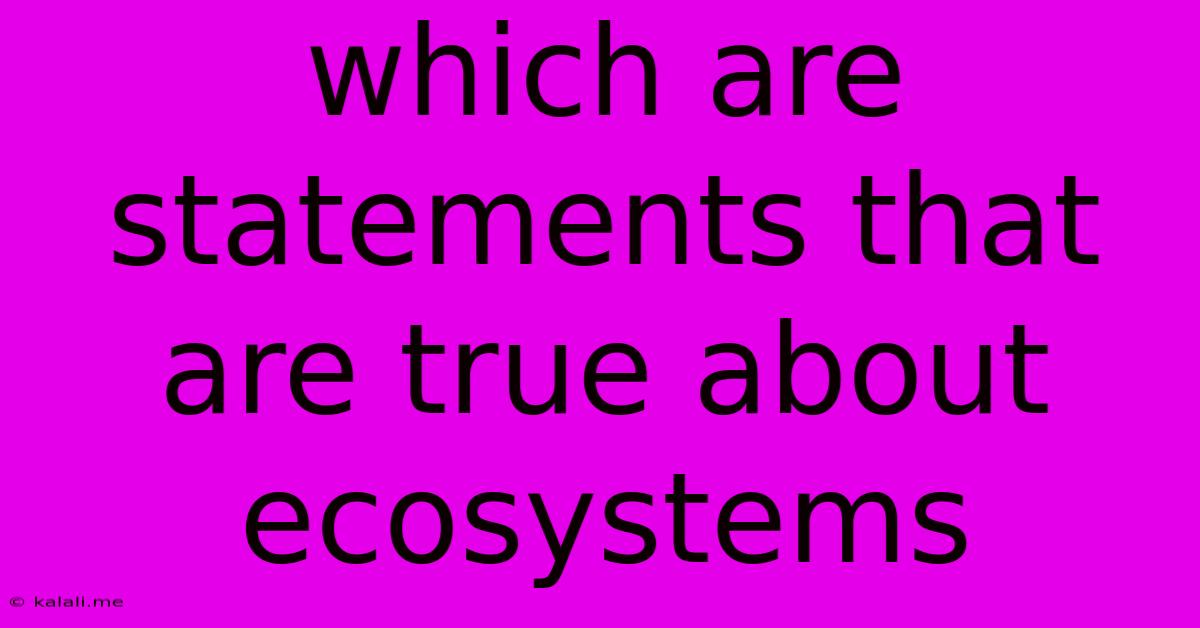Which Are Statements That Are True About Ecosystems
Kalali
Jun 16, 2025 · 3 min read

Table of Contents
Which Statements Are True About Ecosystems? A Deep Dive into Ecological Truths
Meta Description: Uncover the fundamental truths about ecosystems! This article explores key characteristics and processes within ecosystems, clarifying common misconceptions and strengthening your understanding of this vital area of ecology. Learn about energy flow, nutrient cycling, biodiversity, and more.
Ecosystems are the intricate webs of life that sustain our planet. Understanding their core characteristics is crucial for appreciating the delicate balance of nature and the impact of human activities. This article will explore several statements about ecosystems, clarifying which ones are true and explaining the underlying ecological principles.
1. Ecosystems are Self-Regulating Systems
TRUE. Ecosystems possess a remarkable capacity for self-regulation. This means they have inherent mechanisms that maintain their structure and function within certain limits. For instance, predator-prey relationships help control population sizes, preventing any single species from becoming overly dominant. Nutrient cycling ensures the continuous availability of essential resources. While external factors can influence ecosystems, their inherent resilience allows them to adapt and recover from disturbances to a certain extent. This self-regulation is often described as homeostasis, maintaining a stable internal environment despite external changes.
2. Energy Flows Through Ecosystems in a Linear Fashion
FALSE. While energy enters an ecosystem (usually from the sun), it doesn't flow in a simple, linear path. Instead, energy flow is better described as a unidirectional, but complex, process. Energy is transferred through trophic levels (producers, consumers, decomposers), with energy loss at each step due to respiration and heat. This is often visualized using an ecological pyramid, showing the decreasing amount of energy available at each successive level. Therefore, energy flow is more accurately described as a complex network of transfers and transformations, not a simple linear progression.
3. Biodiversity is Crucial for Ecosystem Stability
TRUE. Ecosystems with high biodiversity—a wide variety of species—tend to be more resilient and stable. This is because a greater diversity of species provides a wider range of functional roles and interactions, making the ecosystem less vulnerable to disturbances like disease outbreaks or environmental changes. A diverse ecosystem has more redundancy; if one species is lost, others can often fill its role, preventing a catastrophic collapse. This is a key concept in conservation biology, emphasizing the importance of protecting biodiversity for ecosystem health. This relates to concepts like functional diversity and species richness.
4. All Ecosystems are Equally Resistant to Change
FALSE. The resistance and resilience of ecosystems to change vary greatly depending on factors like climate, species composition, and the frequency of disturbances. For example, a tropical rainforest, with its high biodiversity and complex interactions, may be more resilient to some types of disturbances than a simpler ecosystem like a grassland. Similarly, ecosystems already stressed by human activities, such as pollution or habitat loss, will often be less resistant to further changes.
5. Nutrient Cycling is a Closed System
FALSE. While nutrient cycling within an ecosystem involves the continuous movement of essential elements like nitrogen and phosphorus, it's not entirely closed. Nutrients can be added to an ecosystem through processes like atmospheric deposition (e.g., nitrogen fixation) or geological processes. Similarly, nutrients can be lost from an ecosystem through processes like leaching or erosion. Therefore, nutrient cycling is better described as an open system, with inputs and outputs influencing the overall nutrient pool available to the ecosystem.
Conclusion: Understanding Ecosystem Dynamics
Understanding the complexities of ecosystems is essential for effective environmental management and conservation efforts. By clarifying these common statements, we've highlighted the importance of considering energy flow, nutrient cycling, biodiversity, and resilience when assessing the health and stability of these vital natural systems. Continued research and understanding of these dynamic systems are crucial for ensuring the long-term health of our planet.
Latest Posts
Latest Posts
-
How To Create Clickable Image In Html
Jun 16, 2025
-
What Are The Factors Of 121
Jun 16, 2025
-
What Is A Theme Of The Passage
Jun 16, 2025
-
A Company That Provides Access To The Internet
Jun 16, 2025
-
Which Word Is Closest In Meaning To The Underlined Word
Jun 16, 2025
Related Post
Thank you for visiting our website which covers about Which Are Statements That Are True About Ecosystems . We hope the information provided has been useful to you. Feel free to contact us if you have any questions or need further assistance. See you next time and don't miss to bookmark.